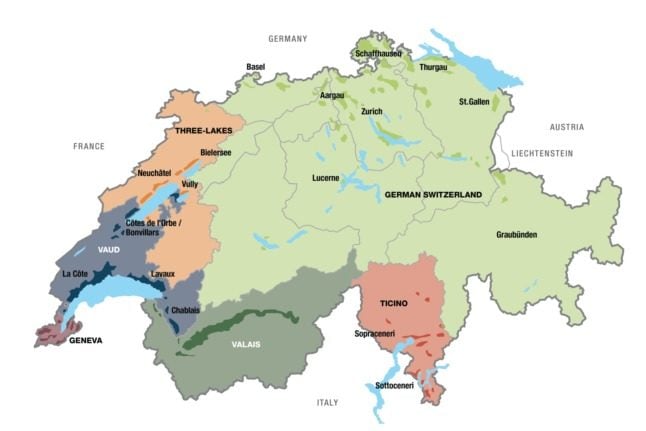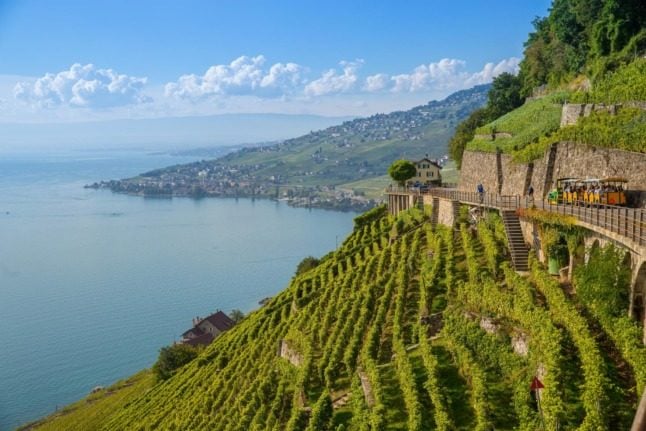EXPLAINED: How to drink wine like a Swiss

When foreigners think of ‘typically’ Swiss foods, cheese and chocolate naturally come to mind. Not many people know, however, that Switzerland is also a wine producing (and drinking) nation.
Many people abroad have no clue that Switzerland produces its own wines because, unlike cheese and chocolate, wine is not widely exported.
In fact, Switzerland exports only 1 percent of its wine. As a comparison, neighbours Italy and France sell abroad 20.8 percent and 13.6 percent of their wine production respectively – including to Switzerland.
The reason is that Switzerland’s 1,500 vintners in six wine-growing areas (Geneva, German-speaking Switzerland, Ticino, Vaud, Valais, and Three Lakes region), barely yield enough grapes to satisfy the domestic demand, much less quench the thirst of other nations.

This is where Swiss wine regions are located. Image: Switzerland Tourism
More than 250 varieties of grapes grow in Switzerland. The most popular is Chasselas (white) — a 12th-century native Swiss variety that originated on the shores of Lake Geneva.
It is still the most dominant grape of the Vaud region, where it makes up 61 percent of the total production. It’s grown widely in the other Swiss wine regions as well, including in Valais, where it is known as Fendant.
Chasselas is also the main grape in Switzerland’s most famous (and spectacularly picturesque) wine-growing area of Lavaux in Vaud. The terraced vineyards sloping into Lake Geneva were recognised in 2007 as the UNESCO World Heritage site.

The terraced vineyards of Lavaux. Photo: Région du Léman
Other popular varieties include Pinot Noir, Gamay, Merlot, Humagne Rouge, Arvine, Savagnin Blanc, Gamaret, Garanoir, Pinot Gris and, in Ticino, Merlot.
What wine do the Swiss like to drink most?
Like everything else in Switzerland, it depends on the canton. Or rather, on the town / village where people live — a reflection of grassroots patriotism so prevalent in this country.
As so many communities produce their own wines from local grapes, residents tend to favour regional wines, though they sometimes do buy bottles “imported” from other areas of Switzerland.
What you should know about wine drinking in Switzerland
You will probably notice that corks pop as soon as at least two people get together, often regardless of what time of the day or night it is.
If you are not a wine aficionado, you may have problems making friends in Switzerland (of course, you could have problems making friends anyway, but that’s an entirely different topic).
In fact, if you refuse a glass of wine without immediately offering medical reasons, you will be eyed suspiciously by the Swiss.
That’s because wine is not only an integral part of social interactions, but a bonding experience as well, which can’t be replicated by drinking, say, a Coke or mineral water.
This is what you should know to fit in
Not surprisingly, given how Swiss people are sticklers for the rules, there is a certain etiquette involved in wine drinking.
To many Swiss people, French wines are, needless to say, inferior (as everything French is), and don’t even try to sell them on Italian or Spanish wines. They will, literally and figuratively, turn up their noses at them. That’s the first point.
Secondly, but just as importantly, if you drink with a Swiss friend, you don’t shout “bottoms up”, then unceremoniously chug your wine down and ask for more. You have to hold your glass by the stem, look into your friend’s eyes, preferably without blinking, for at least five seconds, then clink your glasses.
Only then can you sip your wine, praising its fragrance, aroma, depth of colour, and the Swiss region it came from.
A couple of interesting facts about Swiss wine:
- Switzerland has the smallest vineyard in the world (you didn’t expect it to have the largest, did you?)
Saillon, in Valais, measures 1.6 square-metres and has been owned by the Dalai Lama since 1999.
- It also boasts Europe’s highest vineyard. Below the village of Visperterminen, also in Valais, lies Europe’s highest vineyard at an elevation of between 650m and 1,150m above sea level.
Cheers to that!
EXPLAINED: Why is Switzerland so obsessed with cheese?
Comments
See Also
Many people abroad have no clue that Switzerland produces its own wines because, unlike cheese and chocolate, wine is not widely exported.
In fact, Switzerland exports only 1 percent of its wine. As a comparison, neighbours Italy and France sell abroad 20.8 percent and 13.6 percent of their wine production respectively – including to Switzerland.
The reason is that Switzerland’s 1,500 vintners in six wine-growing areas (Geneva, German-speaking Switzerland, Ticino, Vaud, Valais, and Three Lakes region), barely yield enough grapes to satisfy the domestic demand, much less quench the thirst of other nations.

More than 250 varieties of grapes grow in Switzerland. The most popular is Chasselas (white) — a 12th-century native Swiss variety that originated on the shores of Lake Geneva.
It is still the most dominant grape of the Vaud region, where it makes up 61 percent of the total production. It’s grown widely in the other Swiss wine regions as well, including in Valais, where it is known as Fendant.
Chasselas is also the main grape in Switzerland’s most famous (and spectacularly picturesque) wine-growing area of Lavaux in Vaud. The terraced vineyards sloping into Lake Geneva were recognised in 2007 as the UNESCO World Heritage site.

The terraced vineyards of Lavaux. Photo: Région du Léman
Other popular varieties include Pinot Noir, Gamay, Merlot, Humagne Rouge, Arvine, Savagnin Blanc, Gamaret, Garanoir, Pinot Gris and, in Ticino, Merlot.
What wine do the Swiss like to drink most?
Like everything else in Switzerland, it depends on the canton. Or rather, on the town / village where people live — a reflection of grassroots patriotism so prevalent in this country.
As so many communities produce their own wines from local grapes, residents tend to favour regional wines, though they sometimes do buy bottles “imported” from other areas of Switzerland.
What you should know about wine drinking in Switzerland
You will probably notice that corks pop as soon as at least two people get together, often regardless of what time of the day or night it is.
If you are not a wine aficionado, you may have problems making friends in Switzerland (of course, you could have problems making friends anyway, but that’s an entirely different topic).
In fact, if you refuse a glass of wine without immediately offering medical reasons, you will be eyed suspiciously by the Swiss.
That’s because wine is not only an integral part of social interactions, but a bonding experience as well, which can’t be replicated by drinking, say, a Coke or mineral water.
This is what you should know to fit in
Not surprisingly, given how Swiss people are sticklers for the rules, there is a certain etiquette involved in wine drinking.
To many Swiss people, French wines are, needless to say, inferior (as everything French is), and don’t even try to sell them on Italian or Spanish wines. They will, literally and figuratively, turn up their noses at them. That’s the first point.
Secondly, but just as importantly, if you drink with a Swiss friend, you don’t shout “bottoms up”, then unceremoniously chug your wine down and ask for more. You have to hold your glass by the stem, look into your friend’s eyes, preferably without blinking, for at least five seconds, then clink your glasses.
Only then can you sip your wine, praising its fragrance, aroma, depth of colour, and the Swiss region it came from.
A couple of interesting facts about Swiss wine:
- Switzerland has the smallest vineyard in the world (you didn’t expect it to have the largest, did you?)
Saillon, in Valais, measures 1.6 square-metres and has been owned by the Dalai Lama since 1999. - It also boasts Europe’s highest vineyard. Below the village of Visperterminen, also in Valais, lies Europe’s highest vineyard at an elevation of between 650m and 1,150m above sea level.
Cheers to that!
EXPLAINED: Why is Switzerland so obsessed with cheese?
Join the conversation in our comments section below. Share your own views and experience and if you have a question or suggestion for our journalists then email us at [email protected].
Please keep comments civil, constructive and on topic – and make sure to read our terms of use before getting involved.
Please log in here to leave a comment.